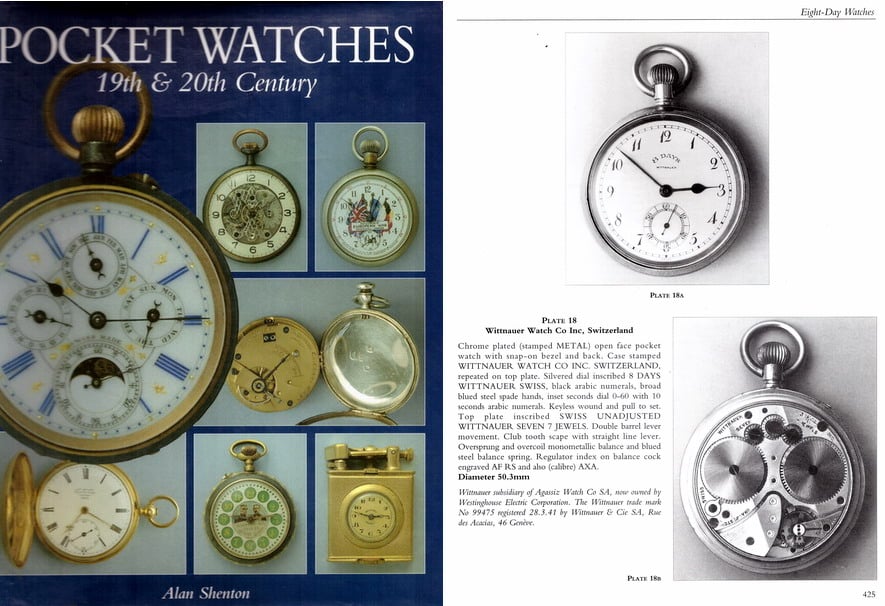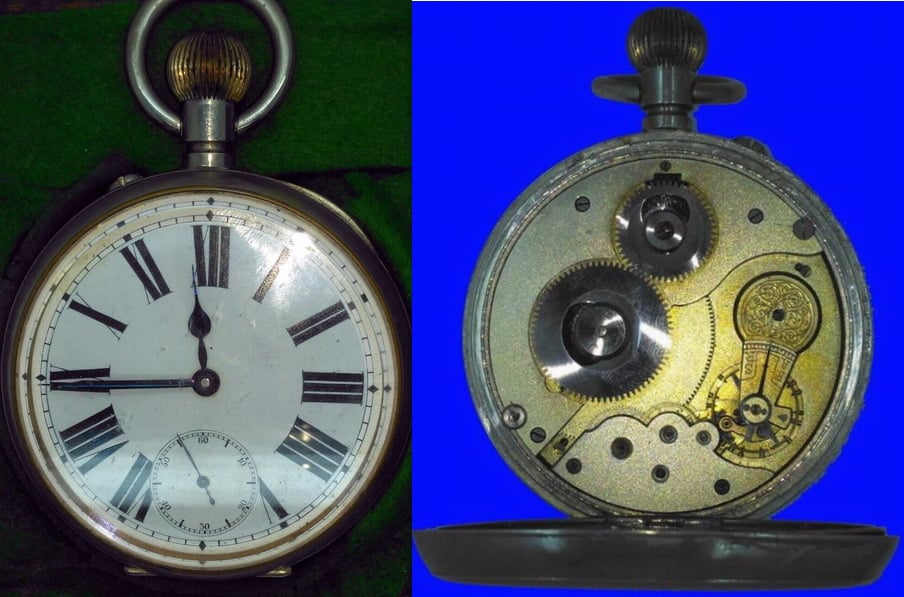OMTOM
·The following is offered for members who might be attracted to the eBay advertisement shown but who are not familiar with these watches. At best it ‘stretches’ the truth (and imagination!) – in places it is simply false.
eBay number 275632424473
As advertised:
WW1 Silver Goliath Patent Military 17J Omega 8-Day Pocket Watch 1916
“A very substantial and rare goliath sized, silveroid 8-day patent Omega pocket watch. The watch in its original silver case and with white enamel dial.”
(I have underlined the words that are false)
The watch shown is indeed a 17-jewel 8-day Omega pocket watch. The watch is not signed Omega – but in these early days they were typically not signed.
The watch shown is an Omega 30’’’8-day calibre – with first entries recorded in the Omega Archive as dating from 1894 (when the Archive started). About 5 years later a very similar 27’’’8‑day calibre was introduced. Both these calibres initially had 15 jewels but in about 1907 both changed to 17-jewel calibres. The two calibres continued in parallel until about 1908 – when production of the 30’’’ ceased: the 27’’’8-day continued until 1926. There were a few 30’’’ watches which were sold later, presumably because the movements had sat on a shelf for some years – but in principle the production of the 30’’’8-day had ceased by the end of 1908.
The advertised watch dates 1908, when it was delivered to UK – so a late example and hence the 17 jewels – but definitely NOT 1916!
Omega made thousands of these 30’’’8-day watches: considerably more than 20,000. They were popular. I think these watches are lovely – but they can certainly NOT be described as rare!
There was no patent (being Swiss it would have been called a ‘Brevet’). Omega has applied for many brevets over the years – but there was no brevet/patent for either the 30’’’ or the 27’’’8-day calibre. For that reason the movement is not marked with a Brevet number.
There was never any evidence of any military connection with the 30’’’8-day – not even for the (more likely) Boer War. Of course it is quite possible that a soldier took with him to the trenches in WWI an old watch (but why carry such a huge, heavy pocket watch when others were available?). But the watch was produced long before WWI and had no military connections. To describe the watch as being “WWI – Military – 1916” is simply wrong, dreaming, and potentially very confusing.
We now turn to the case material – which is Argentan, a nickel alloy. Argentan is sometimes (colloquially) known as ‘German Silver’ – but there is no silver content. It is sometimes (romantically) called ‘silveroid’. As an alloy it consists of Nickel, Copper and Zinc – but no silver. Knowing what we now know about the seller, it is no surprise that the description should be embellished as far as possible. But he even goes as far as saying that the watch is “…in its original silver case…”: this goes beyond the stretching of poetic language – it is simply FALSE!
And now we come to his reference to the book by Alan Shenton (Page 425), presumably to try to give some authenticity to the watch. But it fails. The final chapter in the Shenton book does indeed cover 8-day pocket watches – but at no stage is there any reference to either of the two Omega 8-day calibres of the period. The seller’s reference to Page 425 leads to a Wittnauer watch which is simply different! It would be like comparing an Omega Seamaster Diver with a Rolex Submariner.
Finally, the seller’s claim that “The buy it now price is a clear reflection of the rarity, stunning condition and long-term investment for this watch. Mint watches in this condition, can only rise in value, given the limited supply of such items” is a matter for conjecture. Only time will tell. But in view of the number of similar Omega 30’’’8-day watches (some in very good condition), it would seem very unlikely.
In summary, this is not a Franken: I think it could be called a Walter Mitty watch: dream on.
eBay number 275632424473
As advertised:
WW1 Silver Goliath Patent Military 17J Omega 8-Day Pocket Watch 1916
“A very substantial and rare goliath sized, silveroid 8-day patent Omega pocket watch. The watch in its original silver case and with white enamel dial.”
(I have underlined the words that are false)
The watch shown is indeed a 17-jewel 8-day Omega pocket watch. The watch is not signed Omega – but in these early days they were typically not signed.
The watch shown is an Omega 30’’’8-day calibre – with first entries recorded in the Omega Archive as dating from 1894 (when the Archive started). About 5 years later a very similar 27’’’8‑day calibre was introduced. Both these calibres initially had 15 jewels but in about 1907 both changed to 17-jewel calibres. The two calibres continued in parallel until about 1908 – when production of the 30’’’ ceased: the 27’’’8-day continued until 1926. There were a few 30’’’ watches which were sold later, presumably because the movements had sat on a shelf for some years – but in principle the production of the 30’’’8-day had ceased by the end of 1908.
The advertised watch dates 1908, when it was delivered to UK – so a late example and hence the 17 jewels – but definitely NOT 1916!
Omega made thousands of these 30’’’8-day watches: considerably more than 20,000. They were popular. I think these watches are lovely – but they can certainly NOT be described as rare!
There was no patent (being Swiss it would have been called a ‘Brevet’). Omega has applied for many brevets over the years – but there was no brevet/patent for either the 30’’’ or the 27’’’8-day calibre. For that reason the movement is not marked with a Brevet number.
There was never any evidence of any military connection with the 30’’’8-day – not even for the (more likely) Boer War. Of course it is quite possible that a soldier took with him to the trenches in WWI an old watch (but why carry such a huge, heavy pocket watch when others were available?). But the watch was produced long before WWI and had no military connections. To describe the watch as being “WWI – Military – 1916” is simply wrong, dreaming, and potentially very confusing.
We now turn to the case material – which is Argentan, a nickel alloy. Argentan is sometimes (colloquially) known as ‘German Silver’ – but there is no silver content. It is sometimes (romantically) called ‘silveroid’. As an alloy it consists of Nickel, Copper and Zinc – but no silver. Knowing what we now know about the seller, it is no surprise that the description should be embellished as far as possible. But he even goes as far as saying that the watch is “…in its original silver case…”: this goes beyond the stretching of poetic language – it is simply FALSE!
And now we come to his reference to the book by Alan Shenton (Page 425), presumably to try to give some authenticity to the watch. But it fails. The final chapter in the Shenton book does indeed cover 8-day pocket watches – but at no stage is there any reference to either of the two Omega 8-day calibres of the period. The seller’s reference to Page 425 leads to a Wittnauer watch which is simply different! It would be like comparing an Omega Seamaster Diver with a Rolex Submariner.
Finally, the seller’s claim that “The buy it now price is a clear reflection of the rarity, stunning condition and long-term investment for this watch. Mint watches in this condition, can only rise in value, given the limited supply of such items” is a matter for conjecture. Only time will tell. But in view of the number of similar Omega 30’’’8-day watches (some in very good condition), it would seem very unlikely.
In summary, this is not a Franken: I think it could be called a Walter Mitty watch: dream on.


